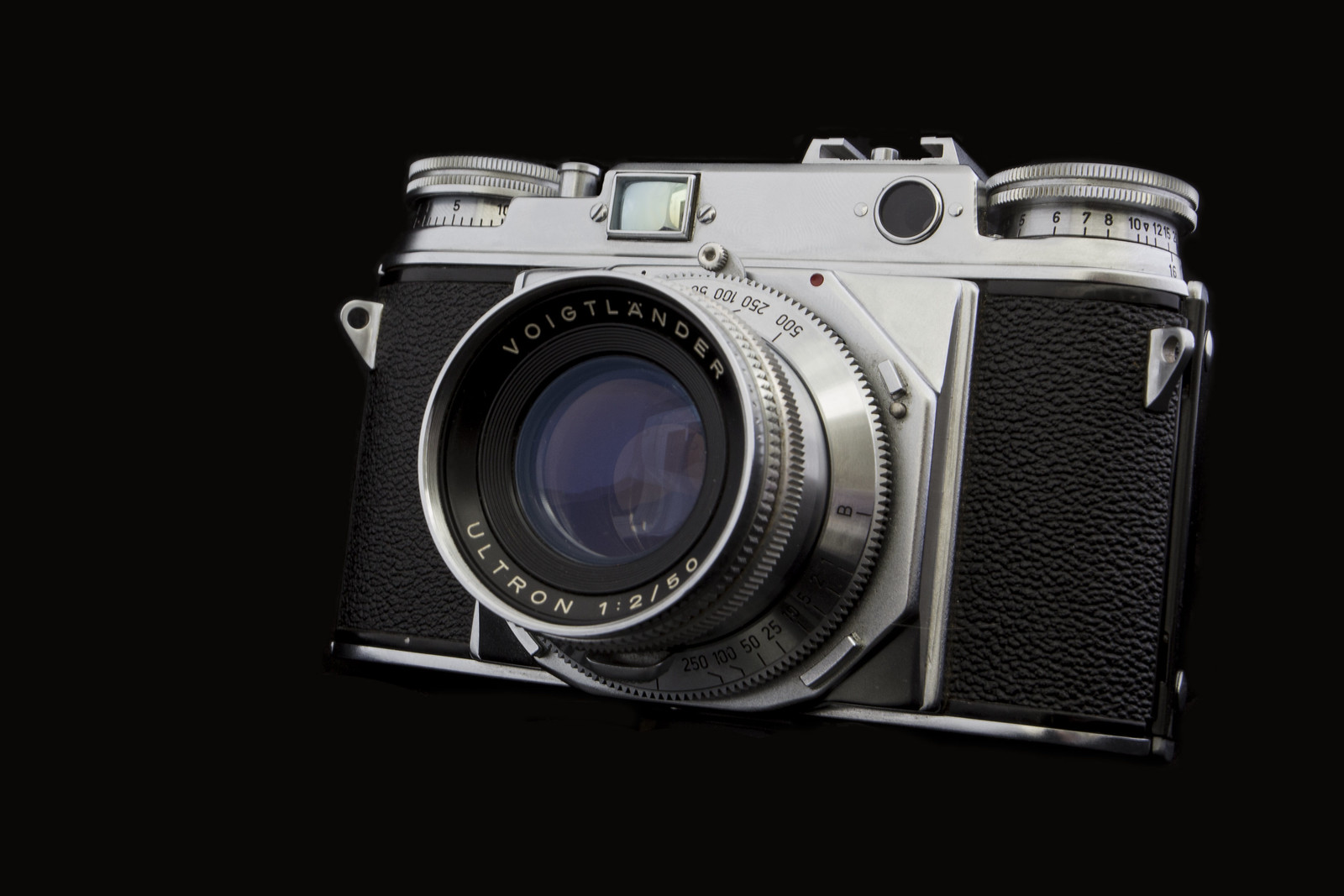 I laughed a little to myself when I read the Craigslist ad, "We know how much it cost, but what is it worth?! Submit your offers and the highest bid will be accepted on April 5th!" The blurry, oddly angled photo taken in bad light betrayed little or no sense of its condition, and I just let it pass. Of course I wanted a nice 1950's era chrome rangefinder, but I'm not really willing to get into a bidding war over one. I've got plenty of cameras already.
I laughed a little to myself when I read the Craigslist ad, "We know how much it cost, but what is it worth?! Submit your offers and the highest bid will be accepted on April 5th!" The blurry, oddly angled photo taken in bad light betrayed little or no sense of its condition, and I just let it pass. Of course I wanted a nice 1950's era chrome rangefinder, but I'm not really willing to get into a bidding war over one. I've got plenty of cameras already.
Come On-a My House
April 5th came and went, and the ad was re-listed. Then it was re-listed again, and then again. No one was biting. Eventually curiosity got the best of me, and I sent an email asking what kind of price range he was looking for. He wanted $200, I politely declined with the excuse that I was just looking for something cheap to take on vacation with me, and I wished him luck.
Here's the fun part: when he heard I was actually going to be using the camera and not just putting it on display somewhere, he offered to give it to me for $100 and the assurance that I'd put it to good use. Apparently it belonged to a friend of his, a 91-year-old veteran that bought it while stationed in Germany sometime around 1951. He agreed to sell it for his friend, who was excited to hear that it might get some use again.
So the adventure began.
Would I Love You
The Prominent is a beautiful camera. In fact, it looks as if it was meant as a museum piece rather than an actual functioning machine. The leatherette is high quality, the chrome shines, and the levers and dials operate with tight tolerances. It's heavy -- surprisingly heavy for its size, which lends to the feeling of quality that this camera exudes in all aspects.
Shutter speeds ranging from 1 second to 1/500 and Bulb are selectable via a ring on the front surrounding the lens. The lens is just as beautiful as the camera, with a nicely damped aperture ring constricting fifteen blades into a near perfect circle at every stop from f/2 to f/16. Focusing is accomplished by moving the entire lens mount and shutter mechanism toward or away from the film plane, with markings on the focus knob for 3.5 feet up to infinity.
A small lever cocks the shutter on the front of the camera, although this is unnecessary for normal use because the shutter is cocked automatically when the film is advanced. This same lever can be pulled slightly past the cocked position before firing to enable the self-timer. Flash synch is selectable between X and M.
As was normal for the time period, the Prominent features no light meter or electronics, and as such does not take batteries. The shutter speeds are mechanically controlled.
 |
| The seller included the camera, two flash units, the leather case, a tripod, three closeup filters, an orange filter, and a polarizer. |
The seller included two flash units: a small electronic flash, as well as a Class M bulb-type flash with expandable reflector dish. Sadly, neither of them were still operational. The Voigtländer filters that were included are nice push-on filters with silver rings matching the camera, and all of them were in perfect condition except for the polarizer, which had degraded over the decades into a worthless mess. I was happy to see the tripod was included, and the fact that it came in the original box was a nice touch, but in reality it hadn't been used in so long that it was difficult to expand and the plastic components were brittle and cracking.
The camera itself exhibited some of the expected symptoms of a 65-year-old camera, including a significant slow down of the shutter speeds below 1/25s. Dialing it down to 1 second and firing, it was a coin toss as to whether it would eventually close again or if I'd need to give the lever a little nudge to help it complete the cycle. The self-timer was also not operational; it would stick, and I'd have to push the lever forward until the shutter tripped.
Un Poco Loco
There's a lot to love with this camera, for sure, so it's interesting to consider what must have been going through the designer's head when he was building it. As much as it is a monument to German engineering, it is also a monument to German over-engineering and complete disregard for user experience.
The first thing that you might notice is that unlike most rangefinders, there is no focus lever surrounding the lens. Normally, this lever is positioned along the base of the lens and allows the user to shift from focus to aperture selection without much effort. Not so with the Prominent. The focus is operated via the large top-mounted dial on the left side of the camera. This puts your hand in an awkward position right next to your head for focusing. The knob travels something like 270°, meaning you can't even focus from one end of the scale to the other without removing and re-centering your grip. The depth-of-field scale is located underneath this knob on the side, so you can't use it without first losing your framing so you can turn it around to face you.
 |
| The ergonomically questionable focus knob |
It doesn't end there, though. The rewind knob has a flip-up key that you turn to rewind the film, but this is a slow and awkward process since you can only really turn it about 180° at a time. It's probably 3 or 4 times slower than a standard 35mm rewind knob.
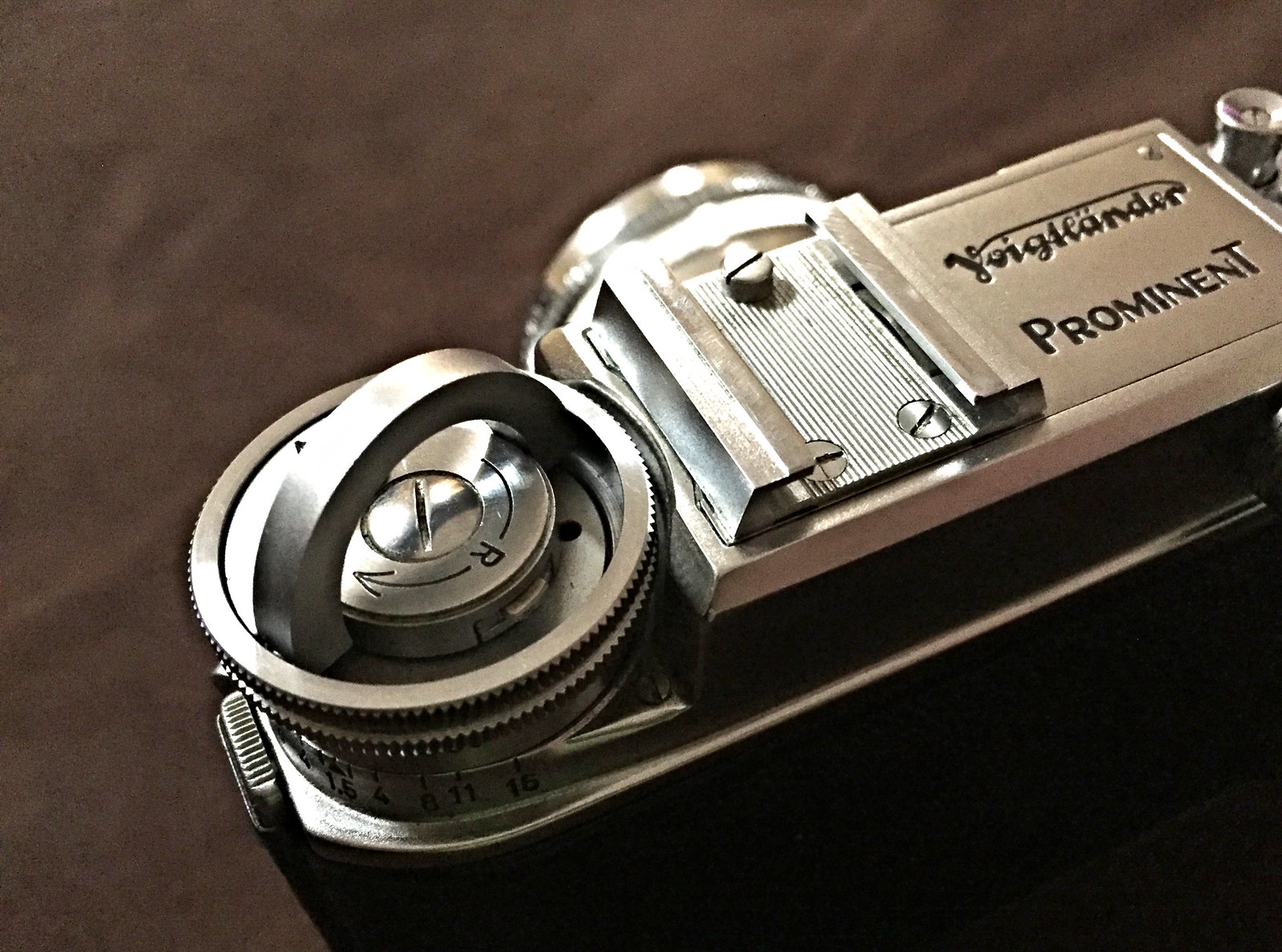 |
| The film rewind mechanism. It's going to be a while. |
Inside, there's one last little bit of craziness, and more than anything else this little guy has been the bane of my existence. Immediately behind the shutter blades is another shutter. I'll get to why this is such a problem for me shortly. But this rear shutter serves no discernible purpose. It's connected to the shutter release button and is designed to be fully open when the primary shutter opens. If you slowly press down on the shutter release while looking into the back of the camera, you can see the blades of the rear shutter slowly opening to reveal the closed shutter in front of it.
The front shutter doesn't let any light through when it's closed, so I see no reason for this secondary shutter. They're even attached to the same button, so what's the point?!
No Matter What You Are
What I had for my $100 was a camera that sort of worked, with the exception of the slowest shutter speeds being way too slow, and a self-timer that was not operating correctly at all. The latter I can handle, but I really wanted to see if I could do something about the shutter speeds. So in a moment of questionable decision making, I found a small point of entry into the mechanics of the shutter and stuck the needle point of a gear oil bottle in there, giving it a little squeeze. My hope was that it would coat some of the components and free up the timing mechanism a little.
Unfortunately, by sticking the end of the needle into the camera I was unable to see how much oil was coming out of the needle and I overdid it by... well, a lot. A little goes a long way with this stuff, and even though it only felt like a little squeeze, apparently I went way too far. All of a sudden both sets of shutter blades were coated in oil, and neither of them were moving as they should anymore.
 |
| Cleaning the shutter blades. Primary shutter is closed in front, rear shutter blades stuck in the partially open position. |
It took many days to clean the shutter blades of the oil that was on them, as well as the oil that would be redeposited on them every time they opened and closed again. I was using lighter fluid and Q-tips at first, but then switched to rubbing alcohol. After a couple of days, the primary shutter started working again. In fact, one good thing that came of this is that I did actually fix the slow shutter speeds! Once the oil was no longer inhibiting the movement of the blades, I felt like I was reaching the end.
Sadly, I still had a lot of work ahead of me, because the secondary shutter mechanism was still moving way too slowly, and was often sticking to the point where even when the shutter release was pressed all the way down, the rear shutter blades would only be partially open. And then releasing them would have no effect, they would just stick there. So for weeks I continued work on these blades. Dabs of alcohol wiped off with a Q-tip, activate the shutter until the blades stick again, repeat the process. To this day, it's not working 100% and I'm still wiping it down almost daily, but it seems to be incrementally improving. I was recently able to take it out and shoot a roll over the course of a couple of hours, and the rear blades didn't begin sticking until near the end of the roll.
One day it will be a reliable camera again, I swear.
I also noticed that the rangefinder spot was out of alignment, so I made the necessary adjustments, and luckily I seem to have gotten that right on the first try.
Que Sera, Sera
Since the sticky rear shutter isn't fully repaired yet, I only have that one test roll to look at. I have to say though, I'm really impressed. This camera may be a bit... unconventional, but the image quality is really surprisingly good for a camera that's old enough to receive social security benefits. The Ultron lens is sharp even at wider apertures, and although I'd like the rangefinder spot to be larger, it's good enough to achieve reasonably quick focus.
The camera is a bit heavy for its size, and combined with the very springy plunger on the shutter release, it's easy to get camera shake at slower shutter speeds, so care should be taken in these circumstances. The fastest shutter speed of 1/500s is offset slightly more on the dial than the other nearby speeds, and the effort required to cock the shutter at this speed is significantly higher. It's actually a little disconcerting because it feels like something inside could snap at any moment, but I assume it only feels that way since I haven't had any problems (and the camera is still operating after 65 years, so that has to count for something!)
There's so much going on with this camera. The crazy design, the incredible optics, the undeniable beauty, the solid brick feel, the odd handling... it's a roller coaster for sure. Once I can get the rear shutter mechanism to operate reliably, I definitely see myself reaching for the Prominent often on my way out the door.
Below are a couple of example photos that I shot on the test roll, including one (inside the Jeep) where you can see the shadows from the rear shutter blades when they got stuck for a frame or two. Once it's working more reliably, I'll add more photos here.

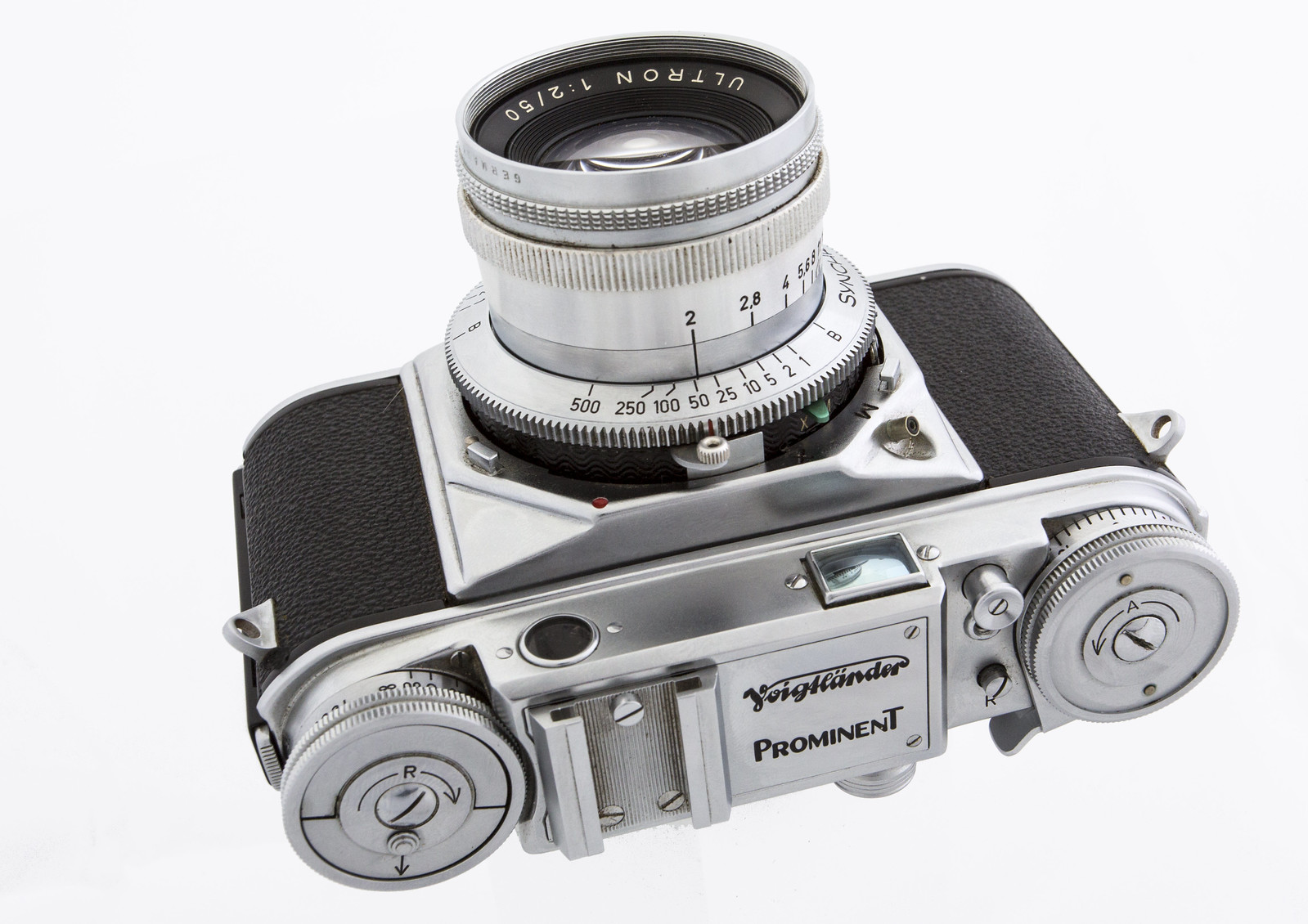

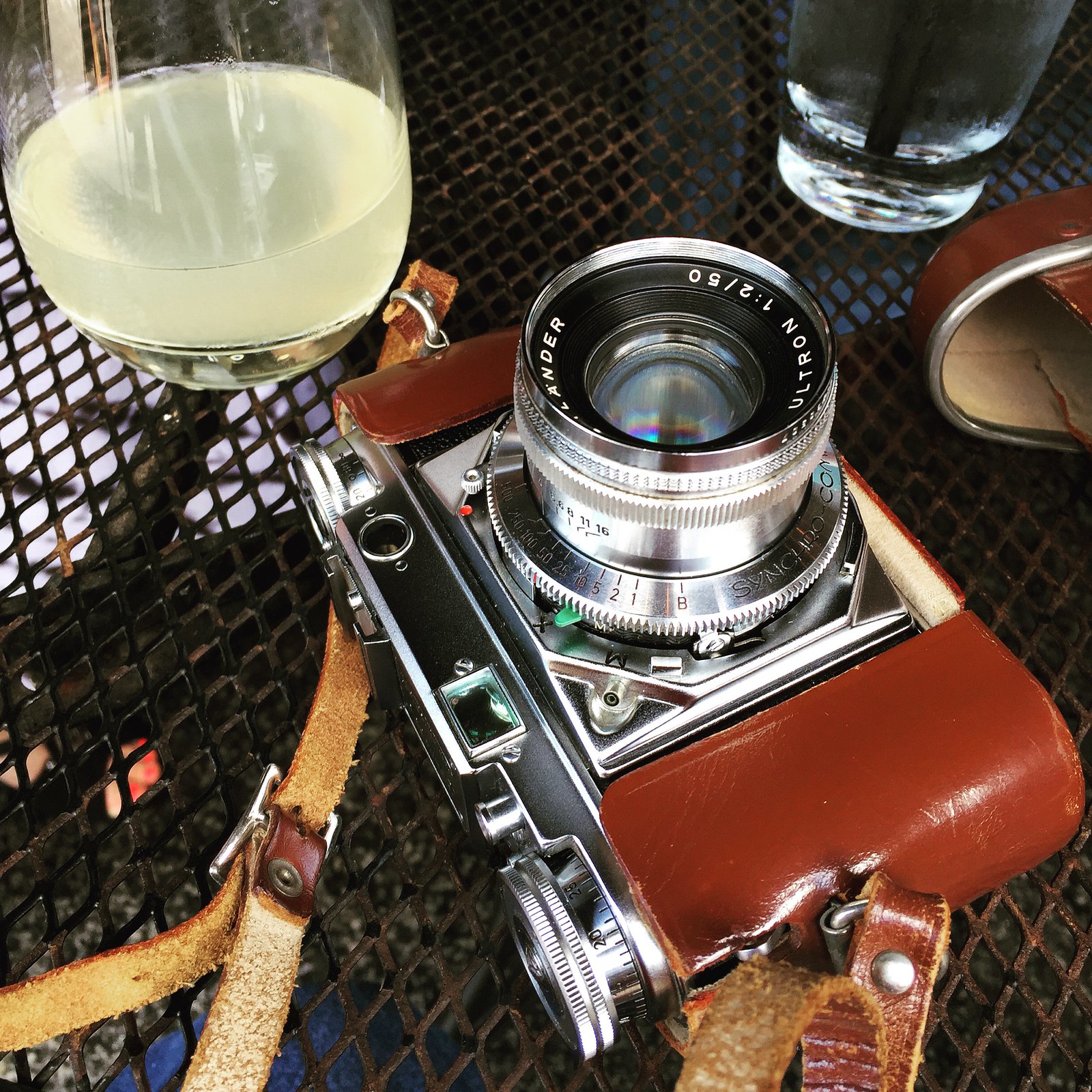
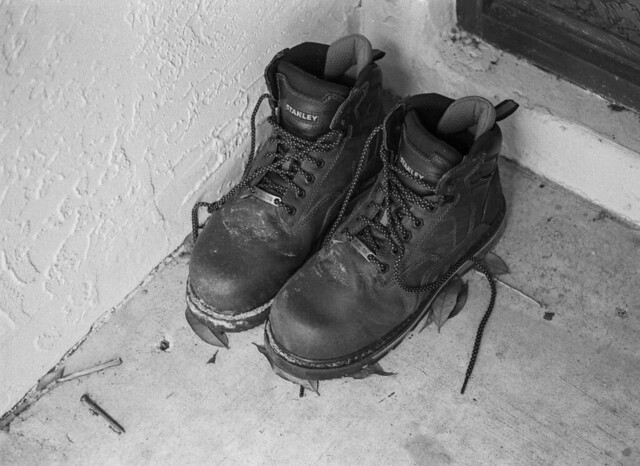
Very nice review, and well said - particularly the "... As much as it is a monument to German engineering, it is also a monument to German over-engineering and complete disregard for user experience."
ReplyDeleteI'd love to own it, since it is on sale for about USD 1K and I don't own a museum - I'll just enjoy your review.
Thanks.
Thanks for your comment, I'm glad you enjoyed the post. :) You can find this version of the Prominent on ebay for about $200, although the price goes up considerably if you look at a set that includes more than one lens.
DeleteSadly, after a few photos with the camera the rear shutter started locking up again, and just recently I picked it back up and started working on it. Hopefully I'll win out for good this time. :)
Hi Jeff,
ReplyDeleteThis version of the Synchro-Compur shutter uses a booster spring to help the 1/500 speed. According to the instruction manual it is recommended to use the manual cocking lever prior to advancing the film. It will ease the load on the advance system.
These Synchro-Compur shutters with the booster spring should only be selected to 1/500, or changed from 1/500 to a slower time, when the shutter is not cocked. Also the self timer (if you get it working) should not be set in conjunction with either Bulb or 1/500. The mechanism is incompatible with these combinations. Hope this assists,
Regards,
Brett
Hello! I'm not sure if you still read these but I thought I'd give it a try. I have a Voigtlander Prominent left to me by my grandfather. I'm just now getting up to speed on using it. One thing I'm very confused about is there seems to be no setting for ISO. How does one go about establishing an accurate exposure setting without that? Would I be at the mercy of a handheld light meter? Many thanks!
ReplyDeleteTrevor
Hi Trevor! The Prominent doesn’t have a light meter, so there’s no need for an ISO selector. You would need an external meter for exposure (if you don’t have one, there are light meter cell phone apps available for free that work pretty well), or you could optionally use The Sunny 16 rule in a pinch. Hope that helps!
DeleteJeff
Jeff, the purpose of the rear shutter may be to prevent the film from fogging when you change lenses. This is assuming the lenses have their own leaf shutters. Regardless, its an amazing piece of engineering.
ReplyDeletethe shutter is not in the lens but behind it so this is not the explanation
Deletehey! acabo de leer tu artículo! muy bueno! debí haberlo leído hace un año atrás!
ReplyDeleteCompré una Prominent con los mismos problemas... pero la desarmé completamente, fue una tremenda odisea montarla nuevamente, pero funciona muy bien. Pero sólo me queda ajustar el telémetro y la perilla de enfoque .... muy linda cámara, pero muy compleja de reparar